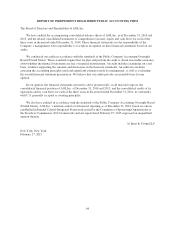America Online 2014 Annual Report Download - page 76
Download and view the complete annual report
Please find page 76 of the 2014 America Online annual report below. You can navigate through the pages in the report by either clicking on the pages listed below, or by using the keyword search tool below to find specific information within the annual report.AOL INC.
PART II—ITEM 7. MANAGEMENT’S DISCUSSION AND ANALYSIS OF FINANCIAL CONDITION
AND RESULTS OF OPERATIONS
judgment is required in assessing and estimating the tax consequences of these transactions. We prepare and file
tax returns based on interpretation of tax laws and regulations. In the normal course of business, our tax returns
are subject to examination by various taxing authorities. Such examinations may result in future tax and interest
assessments by these taxing authorities. In determining our tax provision for financial reporting purposes, we
establish a liability or reduce deferred tax assets for uncertain tax positions unless such positions are determined
to be “more likely than not” of being sustained upon examination, based on their technical merits. That is, for
financial reporting purposes, we only recognize tax benefits taken on the tax return that we believe are “more
likely than not” of being sustained. We record a liability (or reduce deferred tax assets) for the difference
between the benefit recognized and measured pursuant to the accounting guidance for income taxes and the tax
position taken on our tax return. There is considerable judgment involved in determining whether positions taken
on the tax return are “more likely than not” of being sustained. Actual results could differ from the judgments
and estimates made, and we may be exposed to losses or gains that could be material. Further, to the extent we
prevail in matters for which a liability has been established, or are required to pay amounts in excess of the
liability established, our effective income tax rate in a given financial statement period could be materially
affected.
Recent Accounting Standards Impacting Future Periods
Reporting Discontinued Operations
In April 2014, new guidance was issued related to reporting discontinued operations and disclosures of
disposals of components of an entity. The new guidance changes the criteria for determining discontinued
operations and requires additional disclosures of both discontinued operations and certain other disposals that do
not meet the new definition of a discontinued operation. Under the new criteria, a discontinued operation is
defined as a component of an entity or group of components that is disposed of or is classified as held for sale
and represents a strategic shift that has or will have a major effect on an entity’s operations and financial results
or an acquired business that is classified as held for sale on the date of acquisition. In addition, a company is now
permitted to have significant continuing involvement and continuing cash flows with the discontinued operation.
The standard is effective for annual periods beginning on or after December 15, 2014. Early adoption is
permitted, but only for disposals or classifications as held for sale that have not been previously reported. This
new guidance became effective for us in January 2015 and we do not expect it to have a material impact on the
way we disclose discontinued operations.
Revenues from Contracts with Customers
In May 2014, new guidance was issued related to the recognition of revenue. The new guidance will create a
consistent accounting framework for revenue recognition under both U.S. GAAP and International Financial
Reporting Standards. The new guidance will also eliminate industry specific revenue recognition guidance
creating a more robust framework for addressing revenue recognition issues and improving comparability of
revenue recognition practices across entities, industries, jurisdictions and capital markets. The new guidance
requires transactions to be assessed through a five step approach in order to determine the timing and amount of
revenue to be recognized.
The standard will become effective for us in January 2017. Early adoption of the standard is not permitted.
The guidance allows issuers to use one of two transition methods to implement the new standard. The guidance
can be applied retrospectively to each prior reporting period presented or retrospectively with the cumulative
effect of initially applying this update recognized at the date of initial application. We are still in the process of
60
























